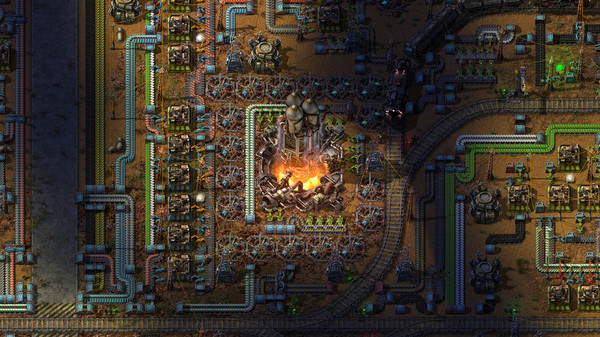Factorio on Steam - User reviews, Price & Information
Factorio is a game about building and creating automated factories to produce items of increasing complexity, within an infinite 2D world. Use your imagination to design your factory, combine simple elements into ingenious structures, and finally protect it from the creatures who don't really like you.
Factorio is a automation, base-building and resource management game
developed and published by Wube Software LTD..
Released on August 14th 2020 is available on Windows, MacOS and Linux
in 30 languages: English, French, Italian, German, Spanish - Spain, Hungarian, Dutch, Norwegian, Polish, Portuguese - Portugal, Portuguese - Brazil, Romanian, Finnish, Swedish, Czech, Russian, Ukrainian, Japanese, Simplified Chinese, Traditional Chinese, Korean, Turkish, Greek, Spanish - Latin America, Thai, Vietnamese, Belarusian, Catalan, Kazakh and Georgian.
It has received 215,209 reviews of which 208,770 were positive and 6,439 were negative resulting in an impressive rating of 9.6 out of 10. 😍
The game is currently priced at 32.00€ on Steam, but you can find it for less on Gamivo.
The Steam community has classified Factorio into these genres:
Media & Screenshots
Get an in-depth look at Factorio through various videos and screenshots.
System requirements
These are the minimum specifications needed to play the game. For the best experience, we recommend that you verify them.
- OS: Windows 11, 10
- Processor: Quad core 3Ghz+
- Memory: 8 GB RAM
- Graphics: DirectX 11 capable GPU with 1GB VRAM - GeForce GTX 750 Ti, Radeon R7 360 or Intel UHD Graphics 730
- DirectX: Version 11
- Storage: 5 GB available space
- Additional Notes: Normal sprite resolution, Low quality compression, 1080p resolution
- OS: OS X 10.10 Yosemite
- Processor: 2016 Mac
- Memory: 8 GB RAM
- Storage: 5 GB available space
- Additional Notes: Normal sprite resolution, Low quality compression, 1080p resolution
- OS: Linux (tarball installation)
- Processor: Dual core 3Ghz+
- Memory: 8 GB RAM
- Graphics: DirectX 11 capable GPU with 1GB VRAM - GeForce GTX 750 Ti, Radeon R7 360 or Intel UHD Graphics 730
- Storage: 5 GB available space
- Sound Card: PulseAudio
- Additional Notes: Normal sprite resolution, Low quality compression, 1080p resolution
User reviews & Ratings
Explore reviews from Steam users sharing their experiences and what they love about the game.
Similar games
View allFrequently Asked Questions
Data sources
The information presented on this page is sourced from reliable APIs to ensure accuracy and relevance. We utilize the Steam API to gather data on game details, including titles, descriptions, prices, and user reviews. This allows us to provide you with the most up-to-date information directly from the Steam platform.
Additionally, we incorporate data from the SteamSpy API, which offers insights into game sales and player statistics. This helps us present a comprehensive view of each game's popularity and performance within the gaming community.
Last Updates| Steam data | 22 October 2025 11:24 |
|---|---|
| SteamSpy data | 21 October 2025 05:59 |
| Steam price | 27 October 2025 12:45 |
| Steam reviews | 25 October 2025 00:08 |
If you'd like to dive deeper into the details about Factorio, we invite you to check out a few dedicated websites that offer extensive information and insights. These platforms provide valuable data, analysis, and user-generated reports to enhance your understanding of the game and its performance.
- SteamDB - A comprehensive database of everything on Steam about Factorio
- SteamCharts - Analysis of Factorio concurrent players on Steam
- ProtonDB - Crowdsourced reports on Linux and Steam Deck Factorio compatibility





















































